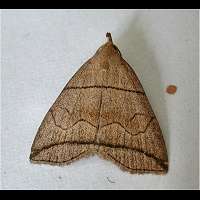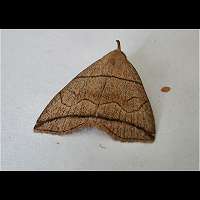Small Fan-foot Herminia grisealis
Of all Fan-feet the Small Fan-foot is the easiest to identify. It is the smallest, as indicated by the name. But the following combination of clues make it very unmistakable. The top line is clear, rather bald and runs straight. The lower line is bald as well and starts in the tip of the wings. The ground colour is greyish brown. And it is quite a small moth, reaching a wingspan of 24 to 28mm.
Even though the eggs are being deposited from June onnwards, the first caterpillars do not appear before July. The caterpillars are somewhat special, for they do not only eat living leaves, but dead ones as well. They are capable of completing their development on the leaves of a broken twig or in leaf litter. In October they make a cocoon to pupate in. The cocoon is made in the crevice of the bark of the foodplant, under loose bark or among the fallen leaves on the ground. The pupa overwinters. The caterpillar of the Small Foot-fan is brownish or reddish brown. It has a distinct, rather broad dorsal line. This line is striking, for it does not begin right behind the head, but rather on the third or fourth segment. The head is greyish brown. The caterpillar reaches a length of 13 to 18mm. A lot of trees and shrubs are used to feed on such as birch, alder, haythorn and Old Man's Beard. The most populair foodplants apparently are oak, beech and bramble.
The Small Fan-foot is on the wing from June to August. Has a second generation in neighbouring countries on the continent. The animal is easily disturbed during daylight and starts it's nightly activities in early dusk. Is attracted to light and sugar, but not in great numbers. Inhabitant of woods, bushy places, parks and often gardens. The Small Fan-foot is a common species in Southern England. Fairly common in other parts of England, Wales and Ireland. A scarce and local species in some of Scotland. The most northern parts of Scotland where the Small Fan-foot has been seen apparently is Ross-shire. A very common species on most of the continent as well.
Of all Fan-feet the Small Fan-foot is the easiest to identify. It is the smallest, as indicated by the name. But the following combination of clues make it very unmistakable. The top line is clear, rather bald and runs straight. The lower line is bald as well and starts in the tip of the wings. The ground colour is greyish brown. And it is quite a small moth, reaching a wingspan of 24 to 28mm.
Even though the eggs are being deposited from June onnwards, the first caterpillars do not appear before July. The caterpillars are somewhat special, for they do not only eat living leaves, but dead ones as well. They are capable of completing their development on the leaves of a broken twig or in leaf litter. In October they make a cocoon to pupate in. The cocoon is made in the crevice of the bark of the foodplant, under loose bark or among the fallen leaves on the ground. The pupa overwinters. The caterpillar of the Small Foot-fan is brownish or reddish brown. It has a distinct, rather broad dorsal line. This line is striking, for it does not begin right behind the head, but rather on the third or fourth segment. The head is greyish brown. The caterpillar reaches a length of 13 to 18mm. A lot of trees and shrubs are used to feed on such as birch, alder, haythorn and Old Man's Beard. The most populair foodplants apparently are oak, beech and bramble.
The Small Fan-foot is on the wing from June to August. Has a second generation in neighbouring countries on the continent. The animal is easily disturbed during daylight and starts it's nightly activities in early dusk. Is attracted to light and sugar, but not in great numbers. Inhabitant of woods, bushy places, parks and often gardens. The Small Fan-foot is a common species in Southern England. Fairly common in other parts of England, Wales and Ireland. A scarce and local species in some of Scotland. The most northern parts of Scotland where the Small Fan-foot has been seen apparently is Ross-shire. A very common species on most of the continent as well.





